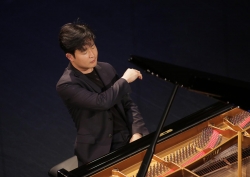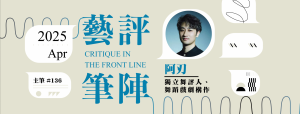 |
The advantages and dangers of being a concert artist today, especially a young and burgeoning one, can hardly be exaggerated. The unlimited space of exposure created by the Internet offers all as much chance of being recognized as of being outrivaled or neglected. The authority of the critic has long lost its sacrosanctity; a democracy of an increasingly educated audience whose gravitating taste decides the fate of artists is, if not already in power, at least keenly anticipated. Thus nothing prepares the artist for popular success more than the ability to identify what is welcomed by the public, a task which unavoidably stands in potential tension with that of the artist’s individual pursuit. Korean pianist Yekwon Sunwoo achieved a fortunate synthesis of both tasks when he emerged triumphant at the 2017 Van Cliburn International Piano Competition. With the exception of Schubert’s music, he brought the same recipe of success to Hong Kong on 23 February. Despite the enthusiasm of the Hong Kong audience, Sunwoo’s performance of Schubert leaves one unsure whether he will continue to achieve the same synthesis in the future, or whether his individual pursuit may lead him onto artistically more rewarding paths.
But let me return to the Schubert at the end. It is clear from Sunwoo’s Van Cliburn programme, consisting of Strauss-Grainger, Hamelin, Rachmanionv and Ravel, that he belongs naturally to the league of keyboard virtuosi that dominate the scene of young concert pianists today. The extraordinary level of technical proficiency now considered a basic requirement means an impressive and even distinguishable style of delivery must be sought. This Sunwoo accomplished most remarkably in the latter half of the concert with Rachmaninov’s Second Sonata and Ravel’s La Valse. The thunderous chords of the Sonata were voiced in a full-blooded manner that did full justice to the stentorian sonority of the Steinway. Small phrasal inflections, tonal shadings and subtle shifts in articulation were spontaneously, unexpectedly but felicitously executed. Sunwoo played with feverish abandon throughout, more volatile and sharper than his 2017 Van Cliburn recording of the same piece, occasionally teetering on the edge of technical control, but succeeding at last in drawing out a surging, awe-inspiring climax in the finale. La Valse, a shorter but no less demanding work, was performed with the finesse necessary for the expression of charm, a transparent texture brought about by judicious pedaling, and the same Rachmaninov-esque abandon that drove the work into an eruptive coda. In both works, the sense of unity in Sunwoo’s dramatic narrative, heightened perhaps by the occasion of a live performance, was what ultimately distinguished his bravura pianism from many others’.
The Strauss-Grainger ‘Ramble’ and Hamelin’s Toccata were performed in a similar vein, but here other factors prevented them from being as totally convincing as what was described above. Admittedly, both Grainger and Hamelin were composer-pianists whose pianistic idioms each border on technical and aesthetic idiosyncrasy. This, together with their relative lack of popularity, makes it doubly difficult for pianists to present these works in an appealing light. Sunwoo’s approach fitted perfectly with the late-Romantic style of writing that united Grainger and Hamelin on the surface, but failed to excavate the idiosyncratic personality in their music. Notwithstanding Sunwoo’s fine execution, nothing memorable remained after Grainger’s extravagant filigrees and harmonic wash faded into silence. But if Grainger than Sunwoo was to blame in this case, one feels certain that Hamelin’s Toccata could be played in a less outright bombastic manner than Sunwoo has chosen to. Those familiar with Hamelin’s performing and composing style will not hesitate to point out that Hamelin never fell prey to the temptation of sheer speed and power to which modern pianism all too often succumb. The diabolical virtuosic effects in Hamelin’s music only truly register when treated not only with the utmost precision, but also with effortlessness, repose and, at times, humour. By succumbing to the aforementioned temptation Sunwoo won immediate applause from the audience, but a close study of Hamelin’s Etude No. 8 (2007), as well as the composer’s own recording (Hyperion, 2010), will reward with a deeper understanding of the Toccata itself.
The problem of musical understanding brings me to Sunwoo’s Schubert. The choice of placing a sonata as vast and serious as D. 958 in the middle of the first half of a recital was itself a peculiar one. It is easy to see that Schubert represents a departure from Sunwoo’s late-Romantic programme. Does Schubert then also represent a real departure from the style of playing to which Sunwoo hitherto adheres? This is not so easy to determine. An interview with the Korean Herald, reproduced in the concert booklet, quoted Sunwoo: ‘I like Schubert’s music. They [sic] may sound simple and monotonous, but for a musician, music of the “king of lieder” feels as if they flow naturally, like water[.]’ Indeed, this is the way in which the repetitive nature of Schubert’s music poses a perennial challenge to performers. It is presumably to surmount this difficulty that Sunwoo frequently introduced interpretive devices into the details of the music. Yet in so doing he sacrificed precisely the natural flow of Schubert’s lines, tampering the dynamic and rhythmic consistency of thematic elements. Moments of exquisite expression could do nothing to rescue the whole of Schubert’s narrative structure from appearing to be weakened and distorted. In an emphatic sense, micromanagement does not constitute an answer to the challenge of Schubert’s music. In the case of D. 958, neither an arch-Beethovenian as Hans Richter-Haaser nor a paradigmatic lyricist as Wilhelm Kempff responded to that challenge by continuously varying the execution of this or that detail. As far as they are located stylistically from each other, they show the necessity of believing in the structural strength of Schubert’s music and allowing it enough stability to develop itself.
In this way Sunwoo remained within the style of playing with which his Rachmaninov and Ravel turned out so successfully. If Schubert’s music entered his programme as a new element, it has not entered his style in the same way. As much could be proven by his choice of three encore pieces, all of them lying comfortably within Sunwoo’s domain: Rachmaninov’s G minor prelude, Liszt’s La Campanella and Tchaikovsky’s ‘October’. But is this and can this be a reproach to Sunwoo’s artistry? Is it after all not necessary that an artist must begin by making himself at home with one style among others? The task of grappling with new styles and new forms of experience can only be meaningful when one stands on a firm ground that has been won by hard labour, something Sunwoo undoubtedly possesses at this point. At the risk of sounding naive, I am tempted to say that only the will to musical understanding is needed to begin with such a task. For if all one seeks is immediate applause and if it has already been granted, nothing will motivate an exploration of unfamiliar territories. But where musical understanding is concerned, it would probably not be worth the trouble of making music, to paraphrase a philosopher, ‘if it failed to teach the musician something he hadn’t known before, if it didn’t lead to unforeseen places, if it didn’t disperse one toward a strange new relation with himself. The pain and pleasure of music is to be an experience.’[1]
[1] Michel Foucault, ‘Preface to The History of Sexuality, Volume II’, in The Foucault Reader, Pantheon Books, 1984, p. 339.
本網站內一切內容之版權均屬國際演藝評論家協會(香港分會)及原作者所有,未經本會及/或原作者書面同意,不得轉載。









